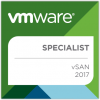Reading Time: 12 minutesThis is an article realized for StarWind blog and focused on the design and architecture of VMware vCenter and PSC topologies. See the original post. You can “federate” multiple vCenter Server systems using vCenter Linked Mode (introduced in vSphere 4.0) to build a single pane of glass and share information between vCenter instances, like view and manage the inventories of all the vCenter Server systems that are linked.
Browsing Posts in VMware
Reading Time: 3 minutesDuring the VMworld 2018 Europe, VMware has announced that it has signed a definitive agreement to acquire Heptio, a leader in the open Kubernetes ecosystem. Terms were not disclosed. Founded in 2016 by Joe Beda and Craig McLuckie, two of the creators of Kubernetes, Heptio has applied its unique insight to a growing set of products, open source projects and contributions to upstream Kubernetes. This is complemented by Heptio’s work with organizations through training, support and professional services that speed integration of Kubernetes and related technologies into the fabric of enterprise IT.
Reading Time: 4 minutesVMware Cloud Foundation (VCF) is VMware’s unified SDDC platform for the hybrid cloud and it’s based on VMware’s compute, storage, and network virtualization technologies to deliver a native integrated software stack that can be used on-premises for private cloud deployment or run as a service from the public cloud with consistent and simple operations. The core components of VMware Cloud Foundation are VMware vSphere, vSAN (for the storage part), and NSX (for the network and security part). It’s more than a simple products bundle, because it gives a full validate stack with a fast provisioning, but also a better […]
Reading Time: 4 minutesNow that Network Virtualization and Software Defined Network are becoming mainstream, there is a new trend in networking: Software-Defined WAN (SD-WAN). What is SD-WAN? SD-WAN is best defined as traffic monitoring and management from physical devices to the application itself, capitalizing on flexibility and agility. This intelligent routing is abstracted into a virtual overlay, enabling a secured pooling of both private and public connections allowing for automation, centralized network control and real-time management across multiple links.

Reading Time: 3 minutesNow that VMware vSphere 6.7 Update 1 was released in GA the “missing piece” was still the Platinum bundle. But now also VMware vSphere Platinum is finally in General Availability (GA). Announced during the VMworld US 2018, VMware vSphere Platinum is an new edition and a new bundle. The new vSphere Platinum is basically VMware vSphere 6.7 Update 1 Enterprise Plus with the addition of VMware AppDefense. Funny but there is no info about the announce credits on VMware Cloud on AWS (Credits worth $10,000 for VMware Cloud on AWS) that now are no more mentioned.

Reading Time: 10 minutesNow that both Microsoft and VMware have officially announced the new released of their virtualization products it’s possible to make some kind of comparison between Hyper-V available on Windows Server 2019 and vSphere 6.7 (like I’ve done some years ago with the Microsoft Hyper-V 2016 vs. VMware vSphere 6.5 article). Comparing two different product is not so easy, also if they are released closed one each other (at least in the same year). You need to found some homogenous aspects to make the comparison, at least at the technical level (but as written, it’s not so […]

Reading Time: 4 minutesVMware certification paths are quite clear with well defined technology paths (DCV, EUC, NV, Cloud) and different levels (VCP, VCAP, VCDX). All certifications require at least one proctored exam (some may require two different exams). The names of all exams and certifications will change using a “year” notation, but the concept remain the same. But there are also other type of exam, non proctored and just on-line version. One example are the Foundation exams.










